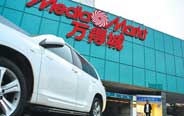
TOKYO, March 1 (Xinhua) -- The Japanese Environment Ministry questioned a World Health Organization (WHO) report which said cancer risk for people in the most contaminated area in Fukushima increased after a nuclear disaster caused by tsunami in 2011 in the prefecture.
The ministry said Thursday that the report "is not a chart predicting the future" and "it is wrong to think what are presented as risks will materialize as shown," Japan's Kyodo News Agency reported Friday, citing an official of the ministry.
The ministry said it is not confirmed that low-dose radiation of 100 millisieverts or lower has impacts on health, adding the ministry's estimate for radiation doses is lower the that of the WHO.
The WHO said Thursday that a comprehensive assessment by international experts on the health risks related to the Fukushima disaster showed that for general population inside and outside of Japan, the predicted cancer risks are low and no observable increases in cancer rates above baseline rates are anticipated.
But the WHO pointed out that the estimated risk for specific cancers in certain subsets of the population in Fukushima has increased and called for long-term continued monitoring and health screening for those people.
The report also specified the estimated risks of cancers, such as breast cancer, leukemia and thyroid cancer, increased for people in the most contaminated area, adding the risks are about one-half of those in the places with highest doses for people in the second most contaminated location in the prefecture.
The Fukushima Daiichi nuclear plant was devastated by disastrous earthquake and tsunami in March 11, 2011, marking the worst nuclear disaster in the world since the Chernobyl accident.


















![]()
